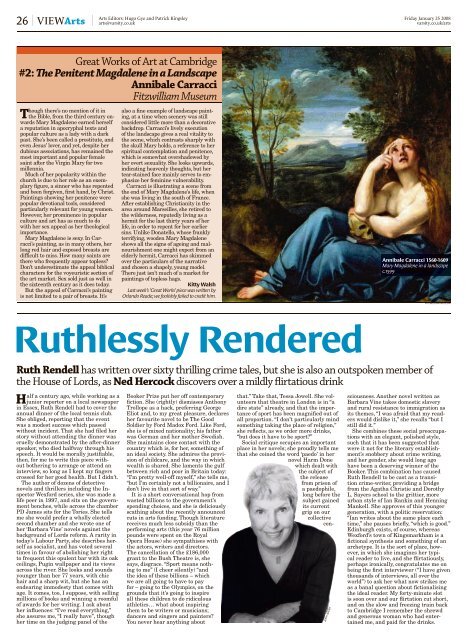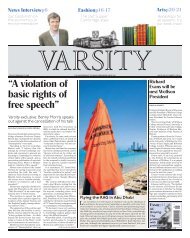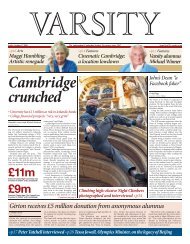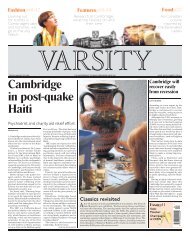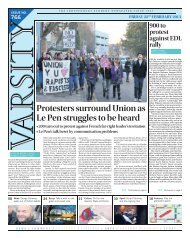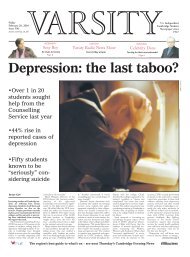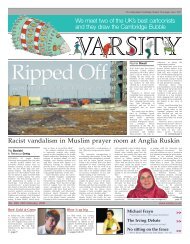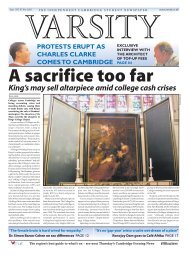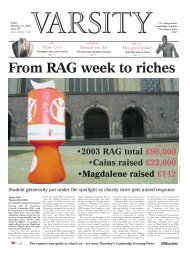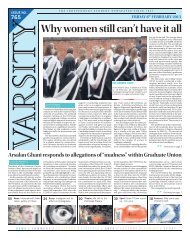Food & Drink Face Off Interview - Varsity
Food & Drink Face Off Interview - Varsity
Food & Drink Face Off Interview - Varsity
Create successful ePaper yourself
Turn your PDF publications into a flip-book with our unique Google optimized e-Paper software.
Arts Editors: Hugo Gye and Patrick Kingsley<br />
26 VIEWArts arts@varsity.co.uk<br />
Friday January 25 2008<br />
varsity.co.uk/arts<br />
Great Works of Art at Cambridge<br />
#2: The Penitent Magdalene in a Landscape<br />
Annibale Carracci<br />
Fitzwilliam Museum<br />
Though there’s no mention of it in<br />
the Bible, from the third century onwards<br />
Mary Magdalene earned herself<br />
a reputation in apocryphal texts and<br />
popular culture as a lady with a dark<br />
past. She’s been called a prostitute, and<br />
even Jesus’ lover, and yet, despite her<br />
dubious associations, has remained the<br />
most important and popular female<br />
saint after the Virgin Mary for two<br />
millennia.<br />
Much of her popularity within the<br />
church is due to her role as an exemplary<br />
figure, a sinner who has repented<br />
and been forgiven, first hand, by Christ.<br />
Paintings showing her penitence were<br />
popular devotional tools, considered<br />
particularly relevant for young women.<br />
However, her prominence in popular<br />
culture and art has as much to do<br />
with her sex appeal as her theological<br />
importance.<br />
Mary Magdalene is sexy. In Carracci’s<br />
painting, as in many others, her<br />
long red hair and exposed breasts are<br />
difficult to miss. How many saints are<br />
there who frequently appear topless<br />
Don’t underestimate the appeal biblical<br />
characters for the voyeuristic section of<br />
the art market. Sex sold just as well in<br />
the sixteenth century as it does today.<br />
But the appeal of Carracci’s painting<br />
is not limited to a pair of breasts. It’s<br />
also a fine example of landscape painting,<br />
at a time when scenery was still<br />
considered little more than a decorative<br />
backdrop. Carracci’s lively execution<br />
of the landscape gives a real vitality to<br />
the scene, which contrasts sharply with<br />
the skull Mary holds, a reference to her<br />
spiritual contemplation and penitence,<br />
which is somewhat overshadowed by<br />
her overt sexuality. She looks upwards,<br />
indicating heavenly thoughts, but her<br />
tear-stained face mainly serves to emphasize<br />
her feminine vulnerability.<br />
Carracci is illustrating a scene from<br />
the end of Mary Magdalene’s life, when<br />
she was living in the south of France.<br />
After establishing Christianity in the<br />
area around Marseilles, she retired to<br />
the wilderness, reputedly living as a<br />
hermit for the last thirty years of her<br />
life, in order to repent for her earlier<br />
sins. Unlike Donatello, whose frankly<br />
terrifying, wooden Mary Magdalene<br />
shows all the signs of ageing and malnourishment<br />
one might expect from an<br />
elderly hermit, Carracci has skimmed<br />
over the particulars of the narrative<br />
and chosen a shapely, young model.<br />
There just isn’t much of a market for<br />
paintings of topless hags.<br />
Kitty Walsh<br />
Last week’s ‘Great Works’ piece was written by<br />
Orlando Reade; we foolishly failed to credit him.<br />
Annibale Carracci 1560-1609<br />
Mary Magdalene in a landscape<br />
c.1599<br />
FITZWILLIAM MUSEUM<br />
Ruthlessly Rendered<br />
Ruth Rendell has written over sixty thrilling crime tales, but she is also an outspoken member of<br />
the House of Lords, as Ned Hercock discovers over a mildly flirtatious drink<br />
Half a century ago, while working as a<br />
junior reporter on a local newspaper<br />
in Essex, Ruth Rendell had to cover the<br />
annual dinner of the local tennis club.<br />
She obliged, reporting that the event<br />
was a modest success which passed<br />
without incident. That she had filed her<br />
story without attending the dinner was<br />
cruelly demonstrated by the after-dinner<br />
speaker, who died halfway through his<br />
speech. It would be morally justifiable,<br />
then, for me to write this piece without<br />
bothering to arrange or attend an<br />
interview, so long as I kept my fingers<br />
crossed for her good health. But I didn’t.<br />
The author of dozens of detective<br />
novels and thrillers including the Inspector<br />
Wexford series, she was made a<br />
life peer in 1997, and sits on the government<br />
benches, while across the chamber<br />
PD James sits for the Tories. She tells<br />
me she would prefer a wholly elected<br />
second chamber and she wrote one of<br />
her ‘Barbara Vine’ novels against the<br />
background of Lords reform. A rarity in<br />
today’s Labour Party, she describes herself<br />
as socialist, and has voted several<br />
times in favour of abolishing her right<br />
to frequent this opulent bar with its oak<br />
ceilings, Pugin wallpaper and its views<br />
across the river. She looks and sounds<br />
younger than her 77 years, with chic<br />
hair and a sharp wit, but she has an<br />
endearing immodesty that comes with<br />
age. It comes, too, I suppose, with selling<br />
millions of books and winning a roomful<br />
of awards for her writing. I ask about<br />
her influences: “I’ve read everything,”<br />
she assures me, “I really have”, though<br />
her time on the judging panel of the<br />
Booker Prize put her off contemporary<br />
fiction. She (rightly) dismisses Anthony<br />
Trollope as a hack, preferring George<br />
Eliot and, to my great pleasure, declares<br />
her favourite novel to be The Good<br />
Soldier by Ford Madox Ford. Like Ford,<br />
she is of mixed nationality; his father<br />
was German and her mother Swedish.<br />
She maintains close contact with the<br />
country which is, for her, something of<br />
an ideal society. She admires the provision<br />
of childcare, and the way in which<br />
wealth is shared. She laments the gulf<br />
between rich and poor in Britain today:<br />
“I’m pretty well-off myself,” she tells me,<br />
“but I’m certainly not a billionaire, and I<br />
don’t live in that sort of way.”<br />
It is a short conversational hop from<br />
wasted billions to the government’s<br />
spending choices, and she is deliciously<br />
scathing about the recently announced<br />
cuts in arts funding. Though literature<br />
receives much less subsidy than the<br />
performing arts (this year 76 million<br />
pounds were spent on the Royal<br />
Opera House) she sympathises with<br />
the actors, writers and directors.<br />
The cancellation of the £186,000<br />
grant to the Bush Theatre is, she<br />
says, disgrace. “Sport means nothing<br />
to me” (I cheer silently) “and<br />
the idea of these billions – which<br />
we are all going to have to pay<br />
for – going to the Olympics, on the<br />
grounds that it’s going to inspire<br />
all these children to do ridiculous<br />
athletics… what about inspiring<br />
them to be writers or musicians;<br />
dancers and singers and painters<br />
You never hear anything about<br />
JERRY BAUER<br />
that.” Take that, Tessa Jowell. She volunteers<br />
that theatre in London is in “a<br />
dire state” already, and that the importance<br />
of sport has been magnified out of<br />
all proportion. “I don’t particularly mind<br />
something taking the place of religion,”<br />
she reflects, as we order more drinks,<br />
“but does it have to be sport”<br />
Social critique occupies an important<br />
place in her novels; she proudly tells me<br />
that she coined the word ‘paedo’ in her<br />
novel Harm Done<br />
which dealt with<br />
the subject of<br />
the release<br />
from prison of<br />
a paedophile,<br />
long before the<br />
subject gained<br />
its current<br />
grip on our<br />
collective<br />
consciousness.<br />
Another novel written as<br />
Barbara Vine takes domestic slavery<br />
and rural resistance to immigration as<br />
its themes, “I was afraid that my readers<br />
would dislike it,” she recalls “but I<br />
still did it.”<br />
She combines these social preoccupations<br />
with an elegant, polished style,<br />
such that it has been suggested that<br />
were it not for the literary establishment’s<br />
snobbery about crime writing,<br />
and her gender, she would long ago<br />
have been a deserving winner of the<br />
Booker. This combination has caused<br />
Ruth Rendell to be cast as a transition<br />
crime-writer, providing a bridge<br />
from the Agatha Christie and Dorothy<br />
L. Sayers school to the grittier, more<br />
urban style of Ian Rankin and Henning<br />
Mankell. She approves of this younger<br />
generation, with a politic reservation:<br />
“Ian writes about the same place each<br />
time,” she pauses briefly, “which is good.”<br />
Edinburgh exists, of course, whereas<br />
Wexford’s town of Kingsmarkham is a<br />
fictional synthesis and something of an<br />
archetype. It is the sort of place, however,<br />
in which she imagines her typical<br />
reader to live, and she flirtatiously,<br />
perhaps ironically, congratulates me on<br />
being the first interviewer (“I have given<br />
thousands of interviews, all over the<br />
world”) to ask her what now strikes me<br />
as a banal question about fictionalising<br />
the ideal reader. My forty-minute slot<br />
is soon over and our flirtation cut short,<br />
and on the slow and freezing train back<br />
to Cambridge I remember the shrewd<br />
and generous woman who had entertained<br />
me, and paid for the drinks.


